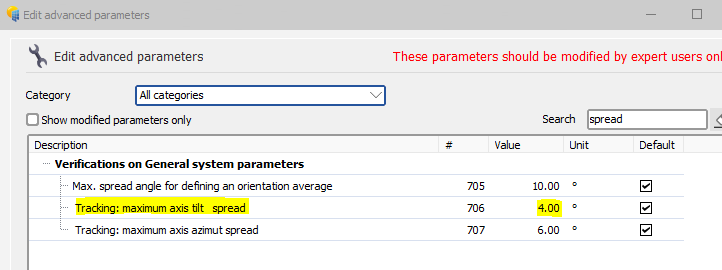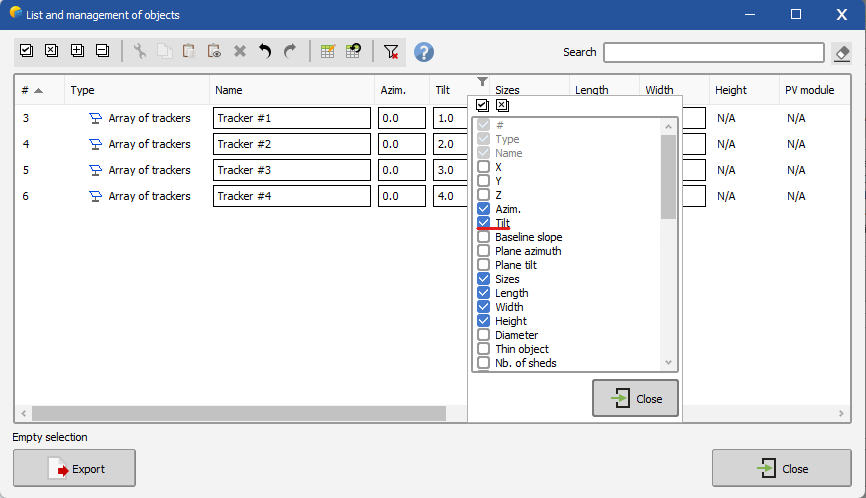-
Posts
793 -
Joined
-
Last visited
Everything posted by Michele Oliosi
-
Other than what is included in the help, I should say that the partition model is an approximation, that tries to account for mismatch between submodules that are shaded or not. On top of that, in the end the inverter decides which operating point to choose on the total IV curve, which can be quite complex for partial shadings. In the situation where a string is on two different rows, you will have 1/2 of the modules being affected by shadings most of the time. This causes an increase in mismatch compared to a situation in which modules are all on the same row. This means that this situation is less resilient to shadings. It ensues that there need to be fewer partitions.
-
Hi, Please read the following help page: https://www.pvsyst.com/help/shadings_partitioninstrings.htm It might be correct for the 2*24 table, but it depends on whether the modules have half cut cells in parallel or not. In case of half-cut cell modules, you should make 4 partitions in Y instead of 2. For the 2*12 table, this is not as resilient to shadings. It's hard to model it with PVsyst, but a good start is: standard modules, leave as is NPartY = 1 half-cut modules, NPartY = 2
-

EW systems orientation from pvcase to pvsyst
Michele Oliosi replied to n.ragavander's topic in How-to
This error message was meant to be present in the previous versions of PVsyst, but a bug prevented it from appearing. This has been fixed in the latest version of PVsyst, that’s why you see the error message now. To get rid of the error message, you can go to the Home window > Settings > Edit advanced parameters, search for “spread” and modify the following value: I hope this helps. Note that cases which have a very large tilt spread may induce a certain uncertainty in the transposition calculation. NB: Please open a new thread if there are issues not related to the original post. -
There is not more direct sunlight on the backside of the modules by increasing the height. Only reflected sunlight on the ground will increase. The maximum irradiance on the ground is found when the tables are high enough so that their own shading of the ground has little impact. This happens relatively fast. Intuitively, if you imagine tables very high up, you can imagine how the shading they cast on the ground is irrelevant in most hours. From that point on, it does not matter at what height they are.
-
There is no mistake in your settings. At the moment, the bifacial backside irradiance model is a 2D view factor model, that approximates the situation of the 3D scene. Shading objects are not represented, neither are differences in height of the tables and so on. One partially related point is that the “Height above ground” in the backside irradiance model definition is not retrieved from the 3D scene either. You should therefore enter it manually according to your system specifications.
-

No azimuth parameter in optimisation tool for SAT
Michele Oliosi replied to Vladislav Iliev's topic in Simulations
Hello, Indeed, the optimization tool is quite rudimentary and doesn't include many parameters to vary. You can however change this parameter with the batch mode, which has many more capabilities than the optimization tool and is useful for more advanced comparative studies. -
We will release more information as it comes along. For the moment, I can just say that it should be expected sometime in 2024. Currently, as mentioned on this recent post we are trying to release V8 this year, as early as it is feasible. We would like to add the sub-hourly modeling correction feature in either of V8.0 or V8.1.
-
What I meant is that if you define a single sub-array containing 100 inverters and, 2114 strings: PVsyst will evaluate the average DC:AC ratio for the sub-array, on this window, only to trigger warnings. In this instance, it does not trigger a warning. For the simulation, PVsyst will consider : 86 inverters with 21 strings x 32PV per string; and 14 inverters with 22 strings x 32PV per string. Instead, if you properly define two sub-arrays with 86 inverters with 21 strings x 32PV per string; and 14 inverters with 22 strings x 32PV per string: For the evaluation of warnings, this time each DC:AC ratio is computed, since this is done sub-array per sub-array. One of the sub-arrays triggers a warning. For the simulation, there is no difference: PVsyst will consider 86 inverters with 21 strings x 32PV per string; and 14 inverters with 22 strings x 32PV per string.
-

Bifacial modules - Tracking, horizontal axis E-W
Michele Oliosi replied to Virgil Ciolponea's topic in Simulations
Dear Virgil Ciolponea, Are you sure you want to use E-W trackers? This type of tracker is more uncommon. NS-axis trackers (turn towards east in the morning and face west in the evening) are more common. Unfortunately, the bifacial calculation only handles NS-axis SAT at the moment. Even though PVsyst will formally allow turning the N-S axis tracker 90° around, it will not lead to good results, especially in backtracking mode (the backtracking of EW and NS axis trackers are different). If you need a bifacial gain value, I would suggest extrapolating the values using a fixed tilt variant to establish an approximation of the bifacial irradiance gains. -

Reset to automatic determination of the inverter PNom limitation mode
Michele Oliosi replied to laurahin's topic in How-to
Hi Laura, Thanks for the suggestion ! Indeed, at the moment other than tweaking the files, there is no way to reset this. I filed a ticket to find a way to reset the state. -

EW systems orientation from pvcase to pvsyst
Michele Oliosi replied to n.ragavander's topic in How-to
Hi, Unfortunately, in v7 it is impossible to have both trackers and fixed structures in the same variant. You should simulate them separately instead. This limitation will be lifted in v8, to be released sometime in 2024. -
Yes, that would be the correct way to proceed. If the irradiance is already reduced by a horizon of some kind, no need to account for it a second time in PVsyst.
-

Batch simulation Engergy output overprediction
Michele Oliosi replied to TKR's topic in Problems / Bugs
In this case, we expect that batch simulation and regular simulation agree. There are however a few reasons for which batch simulation and regular simulation may disagree: The unavailability losses may be randomized again by the batch mode ? Do you have unavailability losses included in your variants ? Aging mismatch losses may be randomized again if they were not “saved as template”. Please check your aging losses. If neither of these are active, please send us an example project and batch parameter file. By the way, you mention 1-20MWh but what is the relative error ? Anything below 0.1% might also be due to rounding errors. -
Hi ! The height above ground is indeed crucial if you are using bifacial modules or large tilt values. For monofacial modules, solely oriented towards the sky, it does not matter too much. Therefore, the height above ground is a parameter in the bifacial model for the backside irradiance. It is available in System, as soon as you choose a bifacial module. The button Bifacial system allows you to parametrize the bifacial modeling.
-

New to Batch, no CSV created plus how to
Michele Oliosi replied to John Dozla's topic in Simulations
The date 1990 is an indicator in PVsyst and not an actual year. It means that the year is generic, i.e., you are using multi-year averages or a TMY. If you import your own time-series data, e.g., via the custom import file, you can choose to use the dates specified in the file. If you then use the MET file created by this procedure, you will be able to choose dates according to your time-series. -
Apart from unlimited orientations, the orientation choices do not allow specifying the distance between trackers. In these cases, the distance between trackers is specified solely by the 3D scene. It is however relatively easy to create an array of trackers in the 3D scene, and the EW pitch i.e., the distance between trackers is one of the parameters.
-
Hi, The axis tilt spread does not impact the simulation results. It just lets you choose what is the maximum tilt difference in your scene. If you don't want to see the error, you can just put a large value in the advanced parameter. Note, however, that the more differences you have in tilt in your scene (independent of the advanced parameter choice), the less the transposition calculation will be precise because of the averaging error.
-

How to adjust varying N/S tilt of multiple trackers
Michele Oliosi replied to Vera's topic in Shadings and tracking
In this case, it is often best to go through the advanced object selection: https://www.pvsyst.com/help/near_shadings_advancedselection.htm If the tilt column is not present, you can right-click on any column header to see the selection of columns: -
Please check the following help page: https://www.pvsyst.com/help/bifacial-conditions.htm This is not a bug but the current limitation of the bifacial model. It is possible to extend the modeling to situations with an inhomogeneous pitch, via the advanced parameters described in the help page (increase the threshold pitch RMS deviation value). The simulation will run, however the results may be somewhat inaccurate for the backside irradiance.



